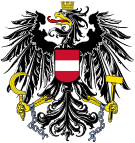| Federal Constitutional Law | |
|---|---|
 Promulgation of the Constitution in the Federal Law Gazette (1920) | |
| Overview | |
| Jurisdiction | Republic of Austria |
| Created | 1 October 1920 |
| Date effective | 10 November 1920 |
| Location | State Archives Building |
| Commissioned by | Constituent National Assembly |
| Author(s) | Hans Kelsen |
| This article is part of a series on the |
| Politics of Austria |
|---|
 |
The Federal Constitutional Law (German: Bundes-Verfassungsgesetz, abbreviated B-VG) is a federal constitutional law in Austria serving as the centerpiece of the Constitution. It establishes Austria as a democratic federal parliamentary republic.
The Law was drafted following the 1918 collapse of Austria-Hungary and was promulgated in 1920. It underwent significant revisions in 1925 and 1929, the latter reform changing the system of government from purely parliamentary to semi-presidential. The Law was superseded by the authoritarian Ständestaat constitution in 1934, which itself became void with the 1938 incorporation of Austria into Nazi Germany. It was reestablished when the nation regained independence from Germany in 1945. The Law was fully restored to force with the end of the Allied occupation in 1955 and has remained in force ever since.

